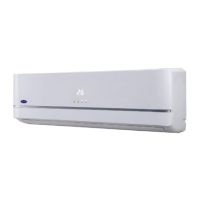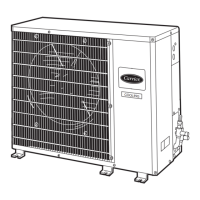18
Step 5—Charging Information
Weigh in appropriate refrigerant charge, then
use the standard practices of superheat-
charging method for piston applications and
subcooling-charging method for TXV
applications to confirm correct charge. The
standard charging methods can be found on
outdoor unit-information plate, in unit
Installation Instructions, or in the Service
Manual. Since total system charge is increased
for long-line applications, it may be necessary
to calculate the additional refrigerant charge.
Since long-line applications only involve 3/8-
in. liquid lines, the additional refrigerant
charge required is 0.6 oz of Refrigerant 22 (R-
22) per ft of 3/8-in. liquid line over 15 ft.
The rating-plate charge of a given outdoor unit
is for a standard application of 15 ft of
interconnecting tubing. The rating-plate charge
can be found on outdoor unit-rating plate or in
outdoor unit-presale literature. Long-line
applications do not require additional oil
charge.
Table 2 —Estimated Percentage of Nominal Cooling-Capacity Losses*
EQUIVALENT LINE LENGTH (FT) UNIT NOMINAL
SIZE (BTUH)
LONG-LINE
VAPOR-LINE
DIAMETER (IN.)**
50 75 100 125 150 175
5/8 5 7 9 12 12 14
18,000
3/4 1 3 4 5 5 7
5/8 6 9 13 16 19 22
24,000
3/4 0 1 1 2 3 4
5/8 6 8 10 13 15 17
30,000
3/4 2 3 4 5 6 7
3/4 7 10 14 17 21 NR
36,000
7/8 2 4 6 8 10 11
3/4 7 10 13 17 20 23
7/8 3 4 6 7 8 10
42,000
1-1/8 0 0 1 1 2 2
3/4 10 14 18 22 NR NR
7/8 4 6 7 9 11 13
48,000
1-1/8 0 0 1 1 2 2
7/8 7 9 11 14 16 19
60,000
1-1/8 1 2 2 3 3 4
*The estimated percentage of cooling capacity that must be subtracted from the Detailed Cooling Capacities data specified in outdoor
unit-presale literature for any given indoor/outdoor combination.
**Vapor-line diameter that may be selected for a long-line application. If smaller vapor lines are selected but not specified within the
table, large capacity losses will occur and defrost capabilities will be reduced. If larger vapor lines are selected but not specified within
the table, refrigerant oil return will be impaired due to velocity losses.
N/R—Not recommended due to excessive loss of capacity.
Step 6—2–Speed Applications
Outdoor units may be connected to indoor
section using accessory tubing package or
field-supplied refrigerant grade tubing or
correct size and condition. In long-line
applications, 2–speed units are handled
basically the same way as the single-speed
units. There are 2 major differences:
1. For tubing up to 100 ft: Liquid tube
diameters and refrigerant connection diameters
for all sizes are 3/8 in.
Vapor tube diameter for the 036 and 048 is 7/8
in.; 060 is 1–1/8
Vapor refrigerant connection diameter for all
sizes is 7/8 in.
DO NOT INSTALL EQUIVALENT
INTERCONNECTING TUBING LENGTHS
GREATER THAN 100 FT.
2. Do not increase or decrease tubing sizes.
For other applications see the previous sections
under Long-Line Guidelines.
EXAMPLE:
To calculate additional charge required for a 25–ft
line set: 25 ft – 15 ft
= 10 ft X 0.6 oz/ft = 6 oz of additional charge

